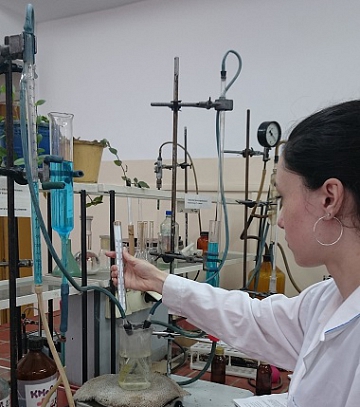Chemists’ skills come useful for aerospace industry development
 Fuel cells are the embodiment of several techniques of conversion of hydrogen into fuel and operate on the principle opposite to electrolysis: gaseous hydrogen and oxygen enter into catalytic, electrochemical reaction producing electrical current, warm and water that is clean enough to be used for drinking. However, oxygen can restore to hydrogen peroxide, which is undesirable. Produced Н2О2 is either exposed to further restoring, or is resolved under catalyst agent distinguishing oxygen. In this regard, the process of hydrogen peroxide catalytic resolving appears to be extremely important for research. ASU Faculty of Chemistry students have an opportunity to study the process directly in the framework of Physical chemistry class.
Fuel cells are the embodiment of several techniques of conversion of hydrogen into fuel and operate on the principle opposite to electrolysis: gaseous hydrogen and oxygen enter into catalytic, electrochemical reaction producing electrical current, warm and water that is clean enough to be used for drinking. However, oxygen can restore to hydrogen peroxide, which is undesirable. Produced Н2О2 is either exposed to further restoring, or is resolved under catalyst agent distinguishing oxygen. In this regard, the process of hydrogen peroxide catalytic resolving appears to be extremely important for research. ASU Faculty of Chemistry students have an opportunity to study the process directly in the framework of Physical chemistry class.
“Living organisms of the planet Earth are “fuel cells”, where mild, regulated, catalyzed “combustion” of hydrogen and oxygen takes place,” says Candidate of Physical and Mathematical Sciences, Assistant Professor of the Department of Physical and Inorganic Chemistry O.A. Maslova. “As a result, electrical, charge-separated energy is produced, and different biochemical processes related to charge transfer occur in the living organisms. The idea of the development of new chemical techniques for electrical energy producing with the help of ecologically clean fuel cells working on hydrogen and oxygen has become especially relevant in the days of impeding energy crisis. The result of such fuel cells’ work is electrical current, warm and water. This breakthrough in hydrogen energetics of the 21st century is used to equip spacecraft, electric vehicles and submarines.”
Such a simple in terms of chemical components fuel cells system shows that the results of fundamental physical and chemical research of catalysis of hydrogen-oxygen compounds conversion is now included into high technologies area. It is particularly about hydrogen peroxide Н2О2.
“Polarization of oxygen electrode is much higher than of hydrogen one, which is based on greater complexity of oxygen restoration processes with producing intermediates of peroxide compounds Н2О2,” explains O.A. Maslova. “Hydrogen peroxide is directly involved in chemical transformations of oxygen on fuel cell cathodic electrode. In these circumstances mild decomposition reaction of hydrogen peroxide is of great importance. It is achieved by using heterogeneous catalysts based on transition and noble metals of platinum group. Due to the above said relevance of fundamental research of mild catalytic hydrogen peroxide decomposition, conducting laboratory work on hydrogen peroxide heterogeneous catalytic combustion is of special interest for Faculty of Chemistry students.”